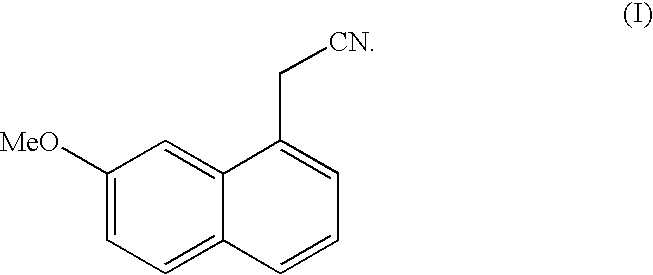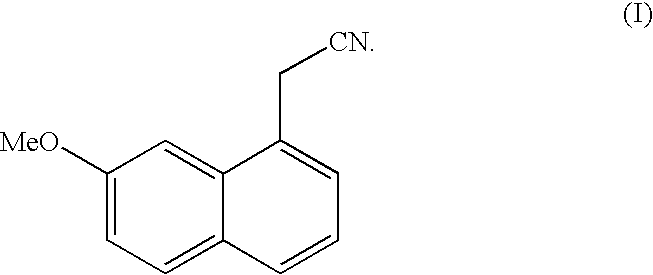Process for the synthesis of (7-methoxy-1-naphthyl)acetonitrile and its application in the synthesis of agomelatine
a technology of acetonitrile and acetonitrile, which is applied in the field of process for the industrial synthesis of (7-methoxy-1-naphthyl) acetonitrile and its application in the industrial production of agomelatine, or n2(7-methoxy1-naphthyl) ethylacetamide, can solve the problems of difficult purification of the mixture of products, low yield, and low carrying
- Summary
- Abstract
- Description
- Claims
- Application Information
AI Technical Summary
Problems solved by technology
Method used
Image
Examples
example 1
(7-Methoxy-1-naphthyl)acetonitrile
Step A: (7-Methoxy-3,4-dihydro-1-naphtlalenyl)acetonitrile
[0042] There are introduced into a 670 litre reactor 85.0 kg of 7-methoxy-1-tetralone, 60.3 kg of cyanoacetic acid and 15.6 kg of heptanoic acid in toluene in the presence of 12.7 kg of benzylamine. The mixture is heated at reflux. When all the starting substrate has disappeared, the solution is cooled and filtered. The precipitate obtained is washed with toluene and then the filtrate obtained is washed with a 2N sodium hydroxide solution and subsequently with water until neutral. After removal of the solvent by evaporation, the resulting solid is recrystallised from an ethanol / water (80 / 20) mixture to give the title product in a yield of 90% and with a chemical purity exceeding 99%.
[0043] Melting point: 48-50° C.
Step B: (7-Methoxy-1-naphthyl)acetonitrile
[0044] There are introduced into a 670 litre reactor 12.6 kg of 5% palladium-on-carbon in toluene, which is heated at reflux; then 96...
example 2
(7-Methoxy-1-naphthyl)acetonitrile
Step A : (7-Methoxy-3,4-dihydro-1-naphthalenyl)acetonitrile
[0046] There are introduced into a 670 litre reactor 85.0 kg of 7-methoxy-1-tetralone, 60.3 kg of cyanoacetic acid and 15.6 kg of heptanoic acid in toluene in the presence of 11.0 kg of aniline. The mixture is heated at reflux. When all the starting substrate has disappeared, the solution is cooled and filtered. The precipitate obtained is washed with toluene and then the filtrate obtained is washed with a 2N sodium hydroxide solution, and subsequently with water until neutral. After removal of the solvent by evaporation, the resulting solid is recrystallised from an ethanol / water (80 / 20) mixture to give the title product in a yield of 87% and with a chemical purity exceeding 99%.
[0047] Melting point: 48-50° C.
Step B: (7-Methoxy-1-naphthyl)acetonitrile
[0048] The procedure is as in Step B of Example 1.
PUM
| Property | Measurement | Unit |
|---|---|---|
| weight | aaaaa | aaaaa |
| purity | aaaaa | aaaaa |
| boiling temperature | aaaaa | aaaaa |
Abstract
Description
Claims
Application Information
 Login to View More
Login to View More - R&D
- Intellectual Property
- Life Sciences
- Materials
- Tech Scout
- Unparalleled Data Quality
- Higher Quality Content
- 60% Fewer Hallucinations
Browse by: Latest US Patents, China's latest patents, Technical Efficacy Thesaurus, Application Domain, Technology Topic, Popular Technical Reports.
© 2025 PatSnap. All rights reserved.Legal|Privacy policy|Modern Slavery Act Transparency Statement|Sitemap|About US| Contact US: help@patsnap.com



